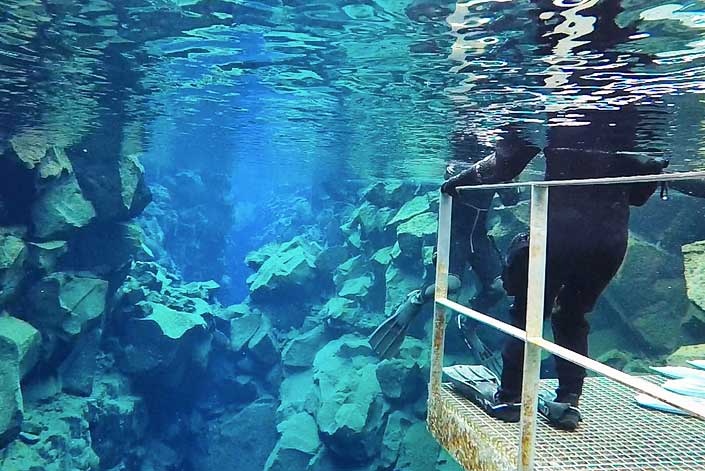D
iving in Silfra is nothing scary, and if you like adventures, you’ll definitely like this one. On the other hand, many people wouldn’t call it easy, let alone comfortable…
Silfra is a beautiful rock crevice flooded by the waters of the lake. You can both dive and snorkel in such an unusual place. But is it worth the effort?
Silfra is a rock fissure formed during the 1789 earthquake. Like much of Iceland, Silfra also lies in the area of divergence of the two great continental plates – the North American and European. To some approximation, it can be said that this, among others, is where the fracture line or boundary between America and Europe runs. As throughout Thingvellir National Park the vertically aligned rocks of Silfra are very evocative and it’s really easy to believe that on one side of the rift we have North America and on the other – Europe. In reality it would be more accurate that ALL you can see from there is the fissure itself – the mid-Atlantic ridge and the border zone between both continents.
The rift is filled with waters of nearby Lake Thingvallavatn (Þingvallavatn) and is certainly part of one of Iceland’s most geographically interesting sites.
For those unaccustomed to diving or with experience mainly from the colorful coral reefs of Egypt or Thailand, diving – or snorkeling – in Silfra is certainly an extraordinary experience.
Here we swim in crystal clear water, in a rock crevice with almost vertical walls only a few meters apart. The underwater azure world of post-volcanic rock rubble and pristine magma landscapes provide an experience that cannot be compared with anything else and is sure to remain in the memory for years to come.

But diving in Silfra is not just “honey and nuts.” Even if we consider the essentially monochromatic rocks devoid of coral reefs, crustaceans, etc. to be interesting and, in their own austere way, beautiful, they are exactly the same rocks as those you will see in the rest of Thingvellir Park.
The most important trouble, however, comes from the fact that we are far to the north, so although the water is fresh (and that’s a huge advantage), its temperature even on the most beautiful day of summer oscillates between 2 and 4 ºC (so 35 to 40 ºF). It is therefore absolutely necessary to wear a so-called dry suit, and this one, although it provides reasonably good thermal comfort, is itself cruelly uncomfortable, especially on the surface before going underwater. The head, neck and hands are less protected from the cold, and the face – except for the mask – is simply doomed to soak in 3 ºC.
In addition, although the lake water is extremely clear, Iceland does not always have beautiful sunny weather. If you hit a cloudy day, it will also be rather grayish-brown underwater. Colorful photos on the websites of dive operators often stretch reality. Those that show a rather monotonous greenish-blue color scheme are much closer to everyday reality. The “pretty” colors will show up only near the surface and/or directly where you shine a strong flashlight.
Paradoxically, it may be more interesting in winter, when you dive just by the light of the flashlights. Just do consider what happens once you leave the 35 ºF water and step out into 30 ºF air. It’s an adventure for the tough…
Snorkeling in Silfra costs around $140 or $185 if you want to be picked up from your hotel in Reykjavik. Diving in Silfra is around $255.
The whole experience is about 3-hour long, but you’ll only spend about 30 to 45 minutes in (or under) the water. You have to select a suit, put it on, go through a mini-training, etc.
Certainly the place – objectively speaking – is one of a kind. ‘Ordinary people’ in few other places in the world can even enter the water in a dry suit. And this alone, to be done in a tectonic crack between two continents, is certainly a very interesting experience.
On the other hand, if you value comfort, then swimming in a drysuit might very well feel extreme for you. And yes, there have been serious accidents here, so do not take it lightly.
And for the more experienced divers – the site itself is not much different to many other rocky locations, except for it being shallow (doesn’t go below 10 m / 30 ft in any place) and quite narrow. If you know the Bells in Egypt, any of the ‘blue holes’ around the world or if you’ve ever dived in an old flooded quarry – this is quite similar. If you want to add this to your tally – sure, go ahead 🙂 But in itself it’s not really worth the cash and even more so – the time you have to spend on it (plus we’re not big fans of diving in rental gear, especially in a rental dry suit…).
Silfra is located on the eastern border of Thingvellir National Park on Road 361. The parking area reserved for divers is on the northern side, and the fissure itself is on the southern side of the road. You can get here from Reykjavik on road 36, heading east. The trip by car takes about 50 minutes.
All dive centers offer pick-up and drop-off of participants from/to Reykjavik. If you don’t want to visit Thingvellir Park itself by the way, it’s worth the transfer, as parking in the park (during the summer season) is not trivial.
If you are interested in details and/or booking your tour, follow these links: